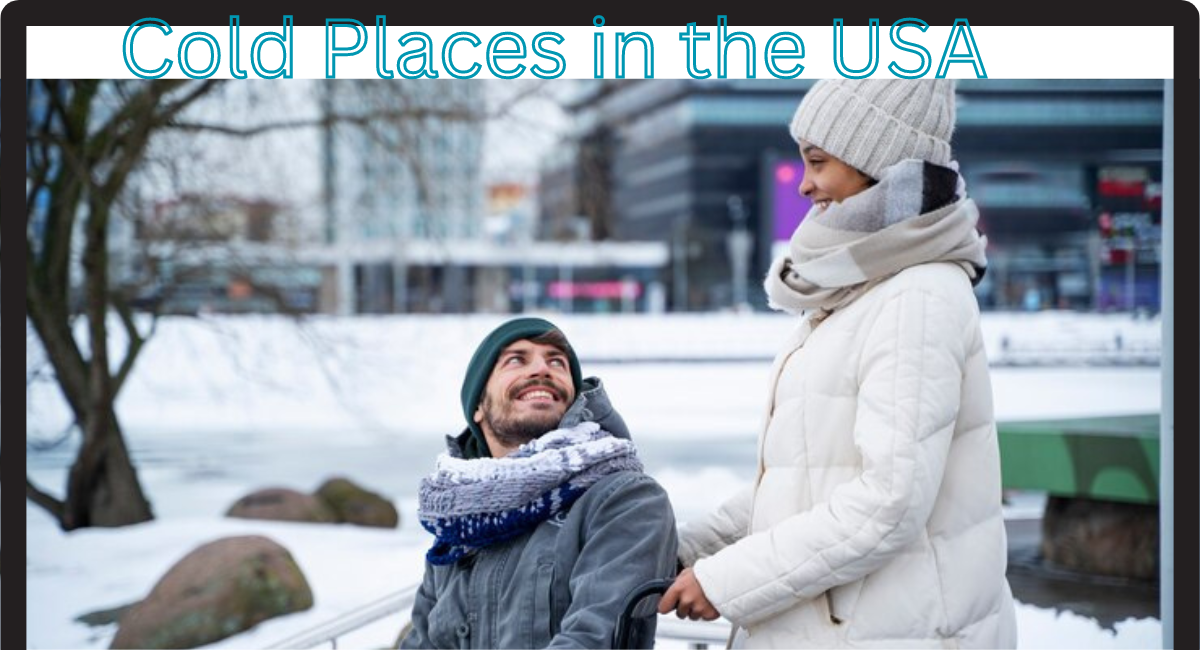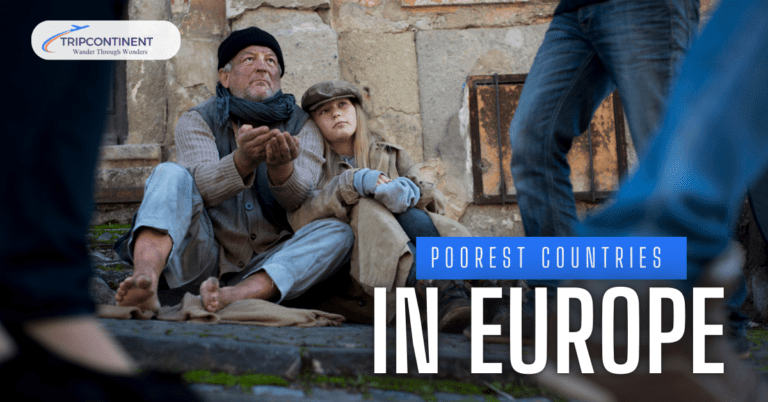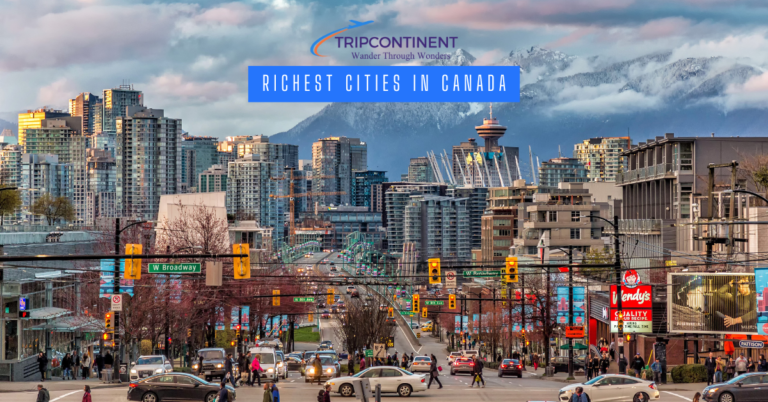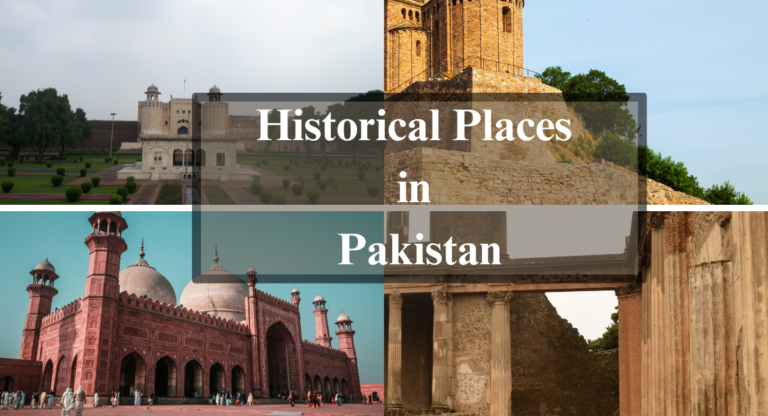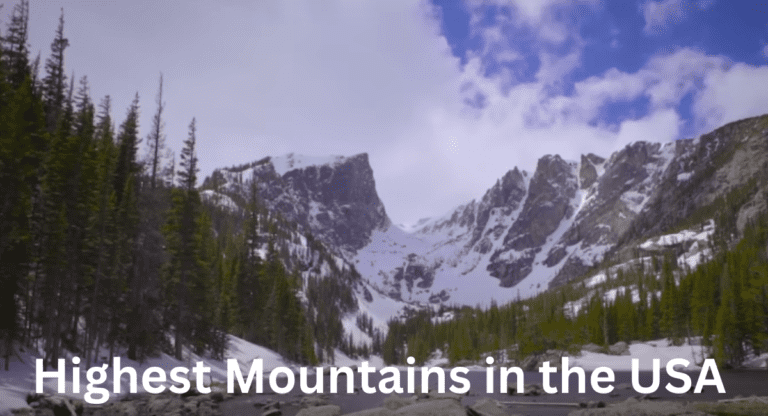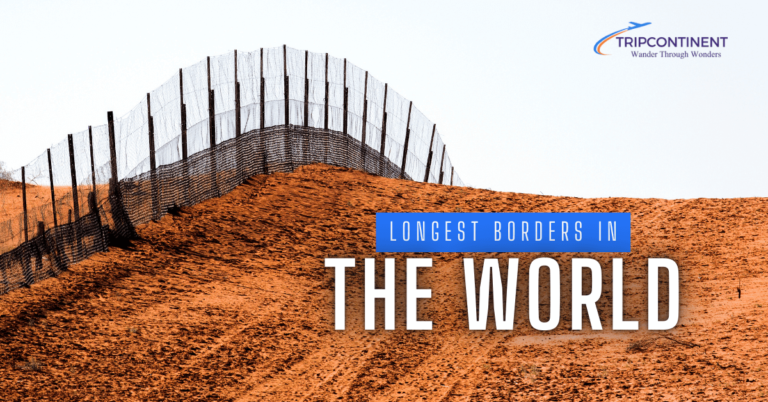Top 12 Cold Places In the USA During Winter
The United States is a land of contrasts, with scorching summers in the south and bone-chilling winters in the north. As winter tightens its grip, temperatures can plummet well below freezing across vast stretches of the country, making life a test of endurance for residents and a winter wonderland for some visitors.
While major cities like Chicago occasionally experience record-breaking cold snaps, the most extreme winter conditions settle over locations further north. Places like Fairbanks, Alaska, and International Falls, Minnesota, become synonymous with super cold temperatures, heavy snowfall, and icy streets. Here, winter isn’t just a season; it’s a way of life.
These frigid cities require a certain level of resilience from their residents. Bundling up in layers becomes a daily ritual, and battling snow and ice becomes a necessary skill. Yet, despite the challenges, these winter wonderlands hold a unique charm. They offer opportunities for snowy adventures and a sense of community forged through shared experiences with the cold.
Are you an adventurer who loves winter and doesn’t shy away from bundling up? This blog might just inspire your next winter adventure! Let’s explore the top Cold Places in the USA.
List Of Top 12 Cold Places In The USA
The top 12 coldest places in the United States are:
- Fargo, North Dakota
- Duluth, Minnesota
- Fairbanks, Alaska
- Barrow, Alaska
- International Falls, Minnesota
- Grand Forks, North Dakota
- Anchorage, Alaska
- Bangor, Maine
- Saranac Lake, New York
- Mount Washington, New Hampshire
- St. Albans, Vermont
- Reno, Nevada
1. Fargo, North Dakota
Fargo is a growing city in North Dakota. It’s the biggest city in the state, with over 136,000 people living there as of 2024. That’s a jump from over 125,000 in 2020. Fargo is like the center of a bigger area that includes parts of Minnesota, with a total population of around 250,000 people.
Fargo sits on a river, the Red River of the North, which provides opportunities for people to enjoy the outdoors. With its mix of city life and nature, Fargo is a great place to live for people and families who want a dynamic community in the Midwest.
Fargo winters are cold and snowy. On average, December and January nights are around 0°F to -10°F (-18°C to -23°C), but it can get even colder during cold snaps, sometimes way below -20°F (-29°C). Fargo gets a good amount of snow every year, averaging around 50 inches (127 cm). Snowstorms can dump several inches of snow quickly, making roads and sidewalks slippery.
Sometimes, Fargo gets hit by blizzards. These storms bring strong winds, blowing snow, and make it almost impossible to see anything. Blizzards can cancel flights, close roads, and make being outside dangerous.
The combination of cold temperatures and strong winds can make it feel even colder in Fargo. This is called wind chill, and it can be dangerous if you’re not dressed warmly enough. Winter in Fargo often comes with wind chill advisories and warnings, letting people know to bundle up.
2. Duluth, Minnesota
Duluth is a busy city in Minnesota, on the shores of a lake called Lake Superior. It’s like a major shipping center, with a big port that sends and receives all sorts of things, like coal, metal, food, and even parts for windmills. This port is super important to the city’s economy.
As of 2024, about 86,500 people are living in Duluth. The number has gone down a tiny bit recently, but it’s still the main city in St. Louis County.
Duluth isn’t just about industry though, it’s also a fun place to visit. Tourists come to see the Great Lakes Aquarium, which has lots of fish and other water creatures, and the cool Aerial Lift Bridge that goes over a harbor. All of this makes Duluth a popular destination in the Midwest.
Duluth gets cold and snowy in winter, but there’s still lots to do. People can ski and snowboard down mountains, or fish on the giant frozen lake. People wear big coats and hats to stay warm outside and sometimes enjoy reading or spending time by a fire inside. With fun things to do outside and cozy places to relax inside, Duluth makes winter a great time to visit.
Also Read: Most Rich States in the USA
3. Fairbanks, Alaska
Fairbanks, also nicknamed “The Golden Heart of Alaska,” is an important Alaskan city. It’s the biggest city in the interior of the state, and the second biggest overall, after Anchorage. Even though Fairbanks isn’t the most populated place, it holds the title of the northernmost major city area in the United States. That means it’s pretty far north, about 200 miles south of the Arctic Circle.
Fairbanks, Alaska has winters that are super cold, dark, and perfect for seeing the Northern Lights. Fairbanks gets brutally cold in winter. December and January nights average -10°F to -20°F (-23°C to -29°C), and it can get even colder, sometimes reaching a bone-chilling -66°F (-54°C).
Because Fairbanks is far north, it experiences “polar nights” during winter. For several weeks around the winter solstice, the sun doesn’t rise above the horizon, making it dark for a long stretch. The long, dark nights are actually a good thing for another reason – they make Fairbanks one of the best places to see the amazing Northern Lights. The colorful lights dance across the dark sky, creating a spectacular natural light show.
Fairbanks gets a decent amount of snow in winter, averaging around 66 inches (168 cm). Snowstorms can bring bursts of snowfall, transforming everything into a winter wonderland. Despite the cold, Fairbanks has tons of fun winter activities. You can go skiing, snowboarding, ice fishing, or take a thrilling dog sled or snowmobile ride through the winter scenery.
Every year, Fairbanks hosts the World Ice Art Championships. This cool event features talented ice sculptors from all over the world creating amazing works of art from big blocks of ice. It’s definitely worth checking out.
4. Barrow, Alaska
Utqiagvik, also known as Barrow, is a big town in the northern part of Alaska. It’s the most important town and the center of administration for the area around it. Barrow is very far north, above the Arctic Circle, and it’s one of the northernmost places in the world where people live. It’s also the northernmost city in the United States. The northernmost point of Barrow is called Point Barrow.
Barrow, Alaska is one of the coldest places people actually live on Earth, and winter there is no joke. Winter in Barrow is brutally cold. December and January nights average a staggering -15°F to -30°F (-26°C to -34°C), and it can get even crazier, sometimes dipping below -50°F (-45°C). Barrow experiences something called a “polar night” during winter. For weeks around December, the sun doesn’t rise above the horizon at all, making it dark for a very long time.
Barrow basically stays in winter mode for a long stretch. Freezing temperatures and snow stick around for a good part of the year. Snow can blanket the ground from October all the way to May.
The cold in Barrow comes with a friend: strong winds. This makes it feel even colder, with wind chill dropping dangerously low. It’s so common to have wind chill advisories in winter that people are practically experts at bundling up to avoid frostbite and hypothermia.
Even though the weather is harsh, Barrow is home to some amazing Arctic animals. Polar bears, caribou, arctic foxes, and seals all call this place home. They’ve toughened up to handle the extreme cold and are an important part of the whole ecosystem.
5. International Falls, Minnesota
International Falls is a town in Minnesota on the border with Canada. It’s the main town of Koochiching County. International Falls started as a small village in 1901 and got its current name two years later because it’s right on the border between the United States and Canada, with a river dividing the two countries. About 5,800 people are living in International Falls.
International Falls, Minnesota is famous for being the “Icebox of the Nation” for a reason – its winters are super cold, with December and January nights averaging a shocking -20°F to -30°F (-29°C to -34°C). It can get even crazier, sometimes dipping below -50°F (-45°C).
Despite the crazy cold, the people in International Falls don’t mind it one bit. They even have a festival called Icebox Days in January to celebrate their freezing fame. The festival has fun stuff like ice sculpting, snowmobiling, and even a polar plunge into an icy lake.
International Falls gets hammered with snow in the winter, averaging around 70 inches (178 cm) every year. Snowstorms can dump a lot of snow at once, making the streets and sidewalks disappear under white piles.
The frozen lakes around International Falls turn into a winter wonderland. People go ice fishing, snowmobiling, and even cross-country skiing on the ice. In some places, the frozen lakes become icy highways for people to travel on.
Even though it’s freezing, people in International Falls love winter sports. Ice hockey, ice skating, and downhill skiing are all popular activities. The city has places to go and trails to explore for all these winter fun things.
With temperatures so cold, staying safe is important. People in International Falls bundle up in layers, cover all their skin, and don’t stay outside for too long to avoid frostbite and hypothermia.
Heating at home in International Falls during winter can be expensive because it’s so cold. People rely on good heating systems like furnaces and wood stoves to keep their houses warm and cozy.
Also Read: Landlocked States in the USA
6. Grand Forks, North Dakota
Grand Forks is a big city in North Dakota, ranking as number three in the state behind Fargo and Bismarck. Almost 59,200 people were living there in 2020, but recently the number has gone down a little bit. Even though the population might be shrinking a bit, Grand Forks is still an important city. It’s connected to a neighboring city on the Minnesota side called East Grand Forks, and together they’re kind of like a bigger place called Greater Grand Forks.
Grand Forks winters are cold and snowy, just like you’d expect in North Dakota. December and January nights are bone-chilling, averaging around 0°F to -10°F (-18°C to -23°C). It can get even colder sometimes, way below -20°F (-29°C).
Winter brings lots of snow to Grand Forks, with an average of 50 inches (127 cm) a year. Snowstorms can blanket the city in white with several inches of snow at a time. Blizzards with strong winds, blowing snow, and terrible visibility can hit Grand Forks in winter. These storms can make traveling dangerous or even impossible.
Strong winds are common in Grand Forks during winter. This wind chill makes it feel even colder than the actual temperature, and it can be dangerous if you’re not bundled up. Winter comes with wind chill advisories to warn people about this risk.
Even though it’s cold, Grand Forks folks love winter sports! Ice hockey, ice skating, skiing, and snowboarding are all popular activities. There are parks and places to go for all these winter fun things.
Lakes and rivers freeze over in winter, creating a wonderland for ice fishing! People fish for walleye, perch, and northern pike under the ice. Ice fishing tournaments are even a popular winter event here.
Grand Forks celebrates the holidays in style with festive events like tree lightings, parades, and visits from Santa. These bring the community together and make winter a fun time.
7. Anchorage, Alaska
Anchorage is a big city in Alaska, one of the biggest. Almost 4 out of every 10 people in Alaska live there, which is more people than live in all of Northern Canada and Greenland put together. As of 2024, about 283,400 people are living in Anchorage, and it’s the main city for Anchorage County.
Anchorage winters are freezing cold and packed with snow. Winter days can be crazy cold, averaging around 5°F to 15°F (-15°C to -9°C) in December and January. Sometimes, it dips even lower, especially during cold snaps.
Anchorage gets slammed with snow every year, averaging around 75 inches (190 cm). Snowstorms can dump a bunch of snow all at once, making the city look like a winter wonderland. Winter days in Anchorage are short, with the sun barely rising in the morning and setting early in the afternoon. Around December, there’s only about 5-6 hours of daylight.
Despite the cold, people in Anchorage love being outside in winter. Skiing, snowboarding, ice skating, and snowshoeing are all popular activities. There are parks and trails all over the city for winter fun. Clear winter nights are perfect for seeing the amazing Northern Lights. These colorful lights paint the sky with greens, purples, and pinks – a beautiful winter sight.
Winter is a festive time in Anchorage with fun events like tree lightings, holiday markets, and winter shows. These bring the community together to celebrate the season.
Be careful driving in winter! Snow and ice can make the roads slippery. Slow down, leave extra space between cars, and consider using winter tires for better traction.
8. Bangor, Maine
Bangor, also known as the “Queen City,” is an important city in Maine. It’s the main city for Penobscot County and the third biggest city in the state, with over 31,000 people living there. The two bigger cities are Portland and Lewiston.
Bangor’s weather can change a lot throughout the year. Winters are cold and snowy, and summers are warm. On average, the city gets around 66 inches (168 cm) of snow every year. Sometimes, snowstorms can dump a ton of snow in just one day, making everything white.
The temperature can be all over the place in Bangor during winter. Normally, it gets pretty cold, around 10°F to 20°F (-12°C to -6°C) in December and January. But sometimes, it can get even colder, especially when there’s a cold snap.
Even though it’s chilly, people in Bangor love being outside in the winter. They go skiing, snowboarding, snowmobiling, and even ice fishing on frozen lakes! If you’re looking for a winter adventure, you can head to places near Bangor like the Appalachian Trail or Baxter State Park for some winter hiking or camping.
Winter is also a festive time in Bangor. There are tree lighting ceremonies, parades, and even visits from Santa. The downtown area gets all decked out with decorations, making it feel like a magical winter wonderland.
9. Saranac Lake, New York
Tucked away in the Adirondack Park, a beautiful park in New York State is a busy village called Saranac Lake. As of 2020, around 4,887 people call this place home, making it the biggest community in the entire park.
Saranac Lake gets its name from three nearby lakes: Upper, Middle, and Lower Saranac. Even though the village isn’t right on those lakes, it does touch the northern part of a lake called Lake Flower and is super close to Lower Saranac Lake. This makes Saranac Lake a perfect spot for people who love spending time on the water or adventuring outdoors.
Saranac Lake turns into a winter wonderland with tons of snow. Every year, the town averages around 70 inches (178 cm) of snowfall, and snowstorms can blanket everything in white with just a few inches in a short time. Being near Lake Placid, Saranac Lake gets even more snow thanks to a cool science trick called “lake-effect snow.” Basically, cold air blows over the warmer lake water and creates extra snowfall.
Winter in Saranac Lake is no joke, with temperatures dropping way down. On average, December and January lows are around 0°F to 15°F (-18°C to -9°C), but it can get even colder during cold snaps.
Despite the chill, Saranac Lake is a winter wonderland for those who love the cold. Skiing, snowboarding, snowshoeing, ice fishing, and snowmobiling are all popular activities. If you’re looking for some serious slopes, Whiteface Mountain and Mount Pisgah are nearby and perfect for skiing and snowboarding adventures.
Winter also brings a special event to Saranac Lake: The Saranac Lake Winter Carnival! This exciting festival features a giant Ice Palace, built entirely out of ice blocks cut from nearby Lake Flower.
Even though it’s cold, Saranac Lake keeps things lively throughout winter. Art exhibits, theater shows, and music concerts fill the local venues and galleries, making it a fun place to be even when the temperatures drop.
10. Mount Washington, New Hampshire
Mount Washington is on top of the White Mountains in New Hampshire. At 6,288 feet (almost 2 miles) tall, it’s the highest mountain in all of the northeastern United States. But Mount Washington isn’t just about how high it is, it’s also famous for its wild and unpredictable weather and its rugged good looks.
People come to visit Mount Washington all year round. Mount Washington might be the toughest mountain for winter weather in the whole world, that’s why they call it “Home of the World’s Worst Weather.”
Mount Washington holds the record for the strongest wind ever recorded on Earth, at a whopping 231 miles per hour. That’s strong enough to blow you right off your feet. Winter storms bring even stronger winds, often exceeding hurricane force (over 100 mph). These winds can make it feel much colder than the actual temperature.
Winter on Mount Washington is freezing. Average lows are around -20°F (-29°C), but the windchill makes it feel even colder. Mount Washington gets slammed with snow every year. The peak averages over 23 feet (7 meters) of snow. Blizzards and whiteouts are common, making it hard to see and dangerous to travel.
Freezing rain and ice storms are also a big problem on Mount Washington in winter. These storms coat everything in ice, making it super slippery and dangerous for hikers and anyone else who might be out on the mountain.
11. St. Albans, Vermont
St. Albans, Vermont is a town with a long history dating back to 1763. It’s known for its farms, beautiful location on Lake Champlain, and role in the Civil War. Today, it’s a mix of historic charm and modern life.
Winters in St. Albans are classic New England: cold, snowy, and sometimes icy. It gets way below freezing, with average lows in the single digits Fahrenheit. Highs are usually in the teens or low 30s Fahrenheit. It snows a lot in St. Albans, with over 80 inches (2 meters) a year on average. The heaviest snowfall is between December and March. Because of nearby Lake Champlain, St. Albans sometimes gets even more snow due to “lake-effect snow.” This happens when cold air picks up moisture from the warmer lake water and dumps it as snow on land. The lake also means great ice fishing in winter.
Just like other parts of New England, St. Albans can get hit by winter storms with heavy snow, strong winds, and ice. People there are used to dealing with these storms, which can sometimes close schools or make travel difficult.
12. Reno, Nevada
Reno, Nevada, founded in 1868, boomed as a railroad town and later with mining and gambling. Today, it’s a hub for casinos, rodeos, and outdoor fun. Winter in Reno is quite different from many places.
Reno sits high and dry in the desert mountains, so winters are mild compared to most. Daytime highs are usually in the 40s or low 50s Fahrenheit, while nights can dip below freezing. Snowfall in Reno itself is pretty rare, with an average of only 20 inches (50 cm) a year. Most of the snow falls in the nearby Sierra Nevada mountains.
Even though Reno doesn’t get much snow, winter can still impact the area. Snow in the mountains can make the roads around Reno tricky, especially for those heading to Lake Tahoe’s ski resorts. Luckily, there’s still plenty to do in Reno during the winter. Since the weather is mild, you can hike, bike, or even golf outdoors. If you prefer staying warm, there are lots of indoor options too, like casinos, shows, museums, and art galleries.
If you’re looking to hit the slopes, Reno acts as a gateway to the amazing ski resorts of the Sierra Nevada, like Mt. Rose Ski Tahoe and Northstar California. You can easily get to these snowy paradises from Reno and enjoy some winter sports fun. So, whether you want some outdoor activity or prefer cozy indoor entertainment, Reno has something to offer in the winter months.
A Table Summarizing the Top 12 Cold Places in the USA
| Place | Average Winter Temperature | Average Snowfall | Winter Activities |
| Fargo, North Dakota | 0°F to -10°F (-18°C to -23°C) | 50 inches (127 cm) | Skiing, snowboarding, ice fishing, snowmobiling |
| Duluth, Minnesota | -20°F to -30°F (-29°C to -34°C) | 70 inches (178 cm) | Skiing, snowboarding, ice fishing, snowmobiling |
| Fairbanks, Alaska | -10°F to -20°F (-23°C to -29°C) | 66 inches (168 cm) | Skiing, snowboarding, ice fishing, dog sledding |
| Barrow, Alaska | -15°F to -30°F (-26°C to -34°C) | 70 inches (178 cm) | Ice fishing, dog sledding, snowmobiling, whale watching |
| International Falls, Minnesota | -20°F to -30°F (-29°C to -34°C) | 70 inches (178 cm) | Ice fishing, snowmobiling, skiing, snowboarding |
| Grand Forks, North Dakota | 0°F to -10°F (-18°C to -23°C) | 50 inches (127 cm) | Ice hockey, ice skating, skiing, snowboarding |
| Anchorage, Alaska | 5°F to 15°F (-15°C to -9°C) | 75 inches (190 cm) | Skiing, snowboarding, ice skating, snowshoeing |
| Bangor, Maine | 10°F to 20°F (-12°C to -6°C) | 66 inches (168 cm) | Skiing, snowboarding, ice fishing, snowmobiling |
| Saranac Lake, New York | 0°F to 15°F (-18°C to -9°C) | 70 inches (178 cm) | Skiing, snowboarding, snowshoeing, ice fishing |
| Mount Washington, New Hampshire | -20°F (-29°C) | 23 feet (7 meters) | Skiing, snowboarding, ice climbing, winter hiking |
| St. Albans, Vermont | Single digits to low 30s°F (-13°C to -1°C) | Over 80 inches (2 meters) | Skiing, snowboarding, ice fishing, winter festivals |
| Reno, Nevada | 40s to low 50s°F (4 to 10°C) | 20 inches (50 cm) | Skiing (nearby), snowboarding (nearby), hiking, indoor entertainment |
Conclusion
These were the top 12 Cold Places in the USA. So, next time you hear about a winter storm wreaking havoc in the south, remember that there are parts of the US where frigid temperatures and snowy landscapes are the norm. These places may test your limits, but they also offer a unique beauty and a chance to experience winter in all its glory.
Whether you crave a cozy fire by the hearth or a thrilling snowmobile ride, there’s a winter wonderland waiting to be discovered in the coldest corners of the US.
FAQs
What Is the Coldest Place in the USA?
If you’re searching for the absolute coldest spot in the US, Fairbanks, Alaska takes the crown. This northern city boasts a record-breaking low of -66°F, making it a place where seriously warm winter gear is a must.
What Is the Coldest City in the World?
The title of the coldest city in the world goes to Yakutsk, Siberia, Russia, where temperatures can dip to a bone-numbing -64°C (-83°F).
What Makes Chicago So Cold in Winter?
Chicago gets so cold in winter because of its location. Sitting at a mid-latitude, it receives much less sunshine in the winter compared to summer. Chicago gets just a fraction of the sun’s warmth compared to summer, leading to those chilly months.
Does It Ever Snow in Texas?
Texas can get snow, but not everywhere and not often. The northern and western parts see more snowfall, with some areas like Amarillo averaging up to 18 inches a year. Southern Texas rarely sees snow.
Which US City Has the Worst Winter?
Fairbanks, Alaska likely takes the cake. Brutal chills reaching -66°F and heaps of snow make it a winter wonderland…or nightmare, depending on your tolerance for the cold.

I’m Sophia Jones, an adventurer at heart from New York City, USA. I live for travel and exploration, always eager to discover new places, meet fascinating people, and try out diverse cuisines. Over the past few years, I’ve traveled to numerous countries, immersing myself in different cultures and creating unforgettable memories.
